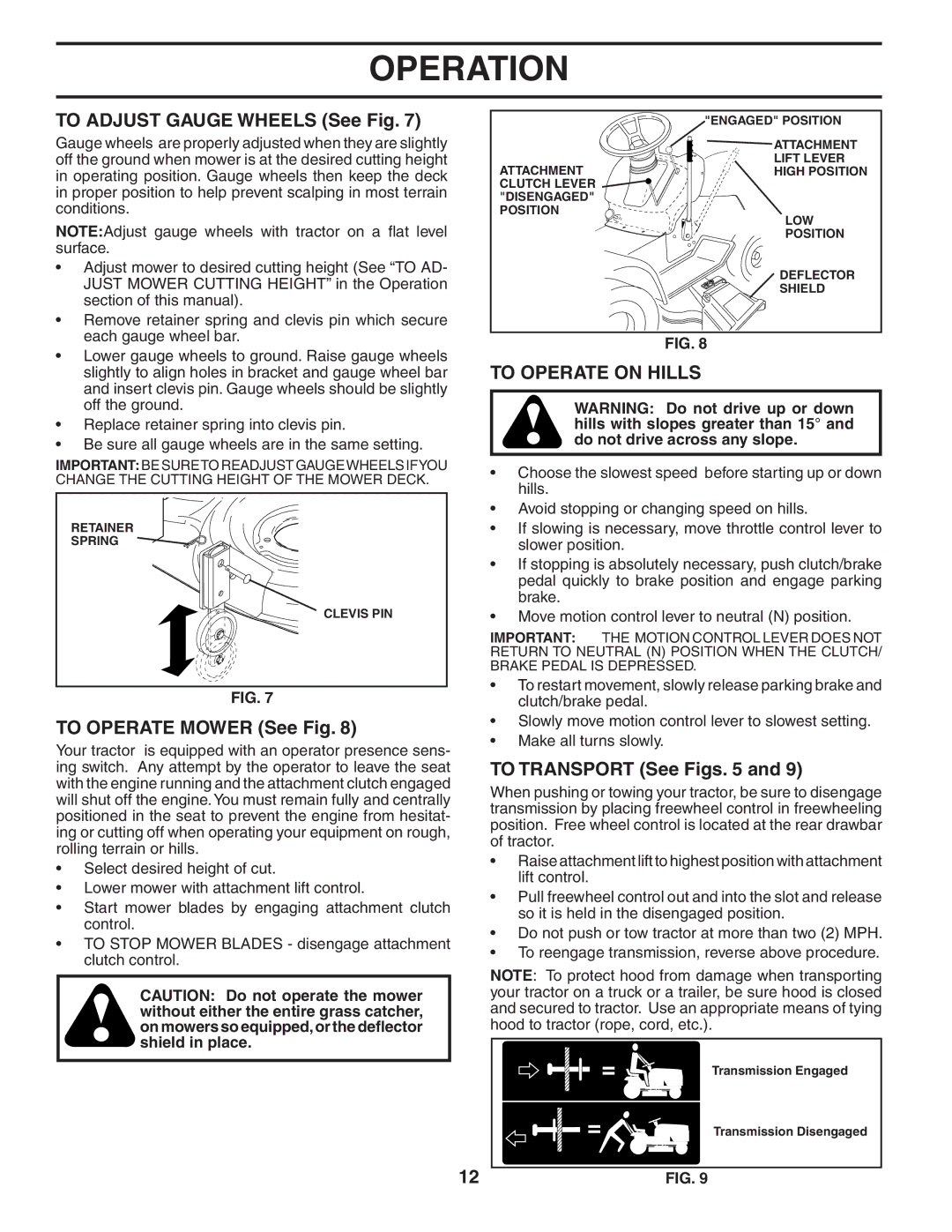
OPERATION
TO ADJUST GAUGE WHEELS (See Fig. 7)
Gauge wheels are properly adjusted when they are slightly off the ground when mower is at the desired cutting height in operating position. Gauge wheels then keep the deck in proper position to help prevent scalping in most terrain conditions.
NOTE:Adjust gauge wheels with tractor on a flat level surface.
•Adjust mower to desired cutting height (See “TO AD- JUST MOWER CUTTING HEIGHT” in the Operation section of this manual).
•Remove retainer spring and clevis pin which secure each gauge wheel bar.
•Lower gauge wheels to ground. Raise gauge wheels slightly to align holes in bracket and gauge wheel bar and insert clevis pin. Gauge wheels should be slightly off the ground.
•Replace retainer spring into clevis pin.
•Be sure all gauge wheels are in the same setting.
IMPORTANT:BE SURETO READJUST GAUGEWHEELS IFYOU CHANGE THE CUTTING HEIGHT OF THE MOWER DECK.
RETAINER
SPRING
CLEVIS PIN
FIG. 7
TO OPERATE MOWER (See Fig. 8)
Your tractor is equipped with an operator presence sens- ing switch. Any attempt by the operator to leave the seat with the engine running and the attachment clutch engaged will shut off the engine. You must remain fully and centrally positioned in the seat to prevent the engine from hesitat- ing or cutting off when operating your equipment on rough, rolling terrain or hills.
•Select desired height of cut.
•Lower mower with attachment lift control.
•Start mower blades by engaging attachment clutch control.
•TO STOP MOWER BLADES - disengage attachment clutch control.
CAUTION: Do not operate the mower without either the entire grass catcher, on mowers so equipped,or the deflector shield in place.
| "ENGAGED" POSITION |
| ATTACHMENT |
ATTACHMENT | LIFT LEVER |
HIGH POSITION | |
CLUTCH LEVER |
|
"DISENGAGED" |
|
POSITION | LOW |
| |
| POSITION |
| DEFLECTOR |
| SHIELD |
FIG. 8
TO OPERATE ON HILLS
WARNING: Do not drive up or down hills with slopes greater than 15° and do not drive across any slope.
•Choose the slowest speed before starting up or down hills.
•Avoid stopping or changing speed on hills.
•If slowing is necessary, move throttle control lever to slower position.
•If stopping is absolutely necessary, push clutch/brake pedal quickly to brake position and engage parking brake.
•Move motion control lever to neutral (N) position.
IMPORTANT: THE MOTION CONTROL LEVER DOES NOT RETURN TO NEUTRAL (N) POSITION WHEN THE CLUTCH/ BRAKE PEDAL IS DEPRESSED.
•To restart movement, slowly release parking brake and clutch/brake pedal.
•Slowly move motion control lever to slowest setting.
•Make all turns slowly.
TO TRANSPORT (See Figs. 5 and 9)
When pushing or towing your tractor, be sure to disengage transmission by placing freewheel control in freewheeling position. Free wheel control is located at the rear drawbar of tractor.
•Raise attachment lift to highest position with attachment lift control.
•Pull freewheel control out and into the slot and release so it is held in the disengaged position.
•Do not push or tow tractor at more than two (2) MPH.
•To reengage transmission, reverse above procedure.
NOTE: To protect hood from damage when transporting your tractor on a truck or a trailer, be sure hood is closed and secured to tractor. Use an appropriate means of tying hood to tractor (rope, cord, etc.).
Transmission Engaged
Transmission Disengaged
12 | FIG. 9 |
